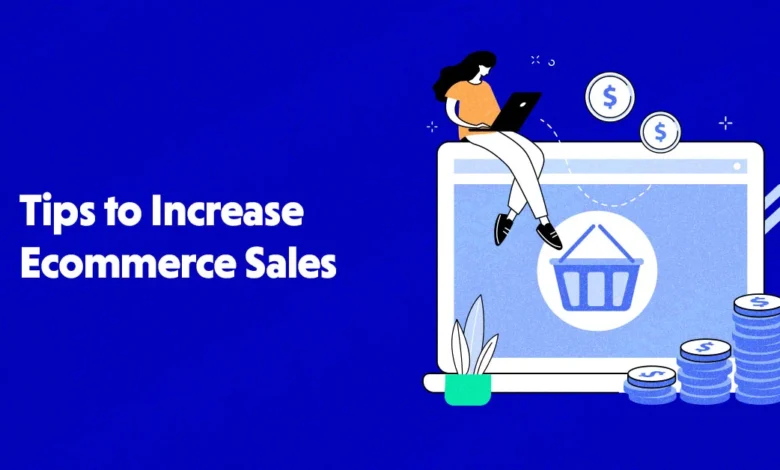7 Tips How to Increase E-commerce Site Sales

Before you start increasing your e-commerce site sales, it’s sample! convert your website impression to clicks, convert clicks into conversions and convert conversions into sales, let discuss how.
Quick overview of the article to save your time. The article guides e-commerce businesses to boost sales by understanding their audience, adding Microsoft clarity optimizing website design, enhancing user experience, implementing conversion rate optimization techniques, offering free shipping, and considering additional features like live chat and loyalty programs. It emphasizes analytics, surveys, and regular testing for continual improvement.
1. Understand Your Audience:
Begin by understanding your target audience. Analyze their preferences, behaviours, and needs. Tailor your offerings to meet these requirements, ensuring that your products resonate with your audience. Here is a quick overview that how to understand your audience;
- Analytics: Use tools like Google Analytics and social media insights.
- Surveys: Gather feedback through surveys to know preferences and opinions.
- Social Media: Listen, engage, and participate in discussions on platforms.
- Website Analytics: Monitor website traffic, popular content, and user behavior.
- Customer Interviews: Conduct one-on-one interviews for qualitative insights.
- Competitor Analysis: Learn from competitors to understand industry trends.
- Adapt Content: Tailor content and messaging based on audience insights.
- A/B Testing: Experiment with different approaches to refine strategies.
- Stay Updated: Keep abreast of industry trends and changes in online behavior.
2. Add Microsoft Clarity to Check Your User Live Activities:
To add Microsoft Clarity to improve sales on your e-commerce site, follow these steps:
- Create a Microsoft Clarity Account:
- Visit the Microsoft Clarity website and sign up for an account.
- Generate Tracking Code:
- After creating an account, you’ll be prompted to create a new project. Follow the instructions to generate a unique tracking code for your website.
- Copy Tracking Code:
- Copy the tracking code provided by Microsoft Clarity. It usually starts with
<script>and ends with</script>.
- Copy the tracking code provided by Microsoft Clarity. It usually starts with
- Insert Code into Website:
- Access the backend of your e-commerce website. Depending on your platform, find the section where you can insert code into the header or footer of your site.
- Paste Tracking Code:
- Paste the copied tracking code into the designated area in your website’s code. This is typically in the header or footer section.
- Save Changes:
- Save the changes to your website’s code and publish the updates.
- Verify Installation:
- Go back to Microsoft Clarity and check for the verification of the tracking code. It may take some time for data to start appearing.
- Explore Insights:
- Once installed and verified, explore the insights provided by Microsoft Clarity. Pay attention to user interactions, click maps, and other features that can help you understand user behavior.
- Optimize Based on Data:
- Use the data gathered by Microsoft Clarity to make informed decisions about optimizing your website. Identify areas for improvement and implement changes to enhance the user experience and, consequently, boost sales.
- Regularly Monitor and Adjust:
- Continuously monitor Microsoft Clarity data and adjust your website based on ongoing insights. Regularly optimizing your site will contribute to sustained improvements in sales.
If you are confused and don’t know how to do this, don’t worry. We are the SEO team, we will explain and setup your microsoft clarity or any other things where are realted to SEO, so don’t be hesetation to Contact Us
By integrating Microsoft Clarity and leveraging its analytics, you gain valuable insights into user behavior, enabling you to make data-driven decisions to enhance your e-commerce site and increase sales.
3. Website Design:
A visually appealing and user-friendly website is crucial. Invest in a clean and intuitive design that facilitates easy navigation. Ensure that your site is responsive across devices to cater to a diverse audience. To design an e-commerce website that maximizes sales, consider the following 15 key elements:
- User-Friendly Design:
- Ensure a clean, intuitive layout with easy navigation.
- Optimize for mobile responsiveness to cater to a wide range of users.
- Clear Product Presentation:
- Use high-quality images and provide multiple views of each product.
- Include detailed product descriptions and specifications.
- Simple Checkout Process:
- Minimize the number of steps in the checkout process.
- Offer a guest checkout option to reduce friction for first-time customers.
- Streamlined Navigation:
- Implement clear categories and filters for easy product discovery.
- Include a search function with autocomplete suggestions.
- Trust Signals:
- Display trust badges, customer reviews, and testimonials.
- Highlight secure payment options to build trust with customers.
- Prominent Call-to-Action (CTA):
- Use compelling CTAs for key actions like “Buy Now” or “Add to Cart.”
- Make buttons visually distinct and strategically placed.
- Up-Selling and Cross-Selling:
- Implement product recommendations based on user behavior.
- Showcase related or complementary products on product pages.
- Discounts and Promotions:
- Highlight ongoing promotions and discounts prominently.
- Consider limited-time offers to create a sense of urgency.
- Optimized Performance:
- Ensure fast loading times to prevent user frustration.
- Optimize images and use a reliable hosting provider.
- User Account Features:
- Allow users to create accounts for a personalized experience.
- Implement a wish list and saved carts for convenience.
- Responsive Customer Support:
- Provide accessible customer support through live chat, email, or phone.
- Include a comprehensive FAQ section to address common queries.
- Secure Payment Options:
- Offer a variety of secure payment methods.
- Clearly communicate security measures to reassure customers.
- Social Media Integration:
- Integrate social sharing buttons for products.
- Utilize social media for promotions and customer engagement.
- Data Analytics:
- Implement analytics tools to track user behavior and site performance.
- Use insights to continually optimize the user experience.
- Email Marketing Integration:
- Collect email addresses for newsletters and promotional updates.
- Implement automated email campaigns for abandoned carts or special offers.
By focusing on these elements, you can create an e-commerce website that not only attracts visitors but also converts them into satisfied customers, ultimately boosting sales. Regularly analyze performance metrics and customer feedback to refine and enhance the user experience. If you are unable to complete this task, you can hire someone from Fiverr. If you are unsure whether the designer will make the necessary changes to your website, take a look at the information below to increase your understanding.
4. Optimize User Experience:
User experience (UX) is paramount. Streamline the buying process, reduce friction, and make it easy for customers to find what they’re looking for. Simplify the checkout process to minimize abandoned carts. Optimize your e-commerce site’s user experience with these key steps:
- Intuitive Navigation:
- Clear categories and a user-friendly menu.
- Mobile Responsiveness:
- Design for mobile and ensure responsive performance.
- Fast Loading Times:
- Optimize images and code for quick page loads.
- Simplified Checkout:
- Minimize checkout steps and offer guest checkout.
- High-Quality Imagery:
- Use clear, high-res product images with zoom features.
- Clear CTAs:
- Compelling calls-to-action for easy navigation.
- Personalization:
- Implement tailored product recommendations.
- Transparent Policies:
- Clearly communicate shipping, returns, and terms.
- Customer Reviews:
- Showcase reviews and encourage user feedback.
- Responsive Support:
- Offer multiple support channels with quick responses.
- Security Measures:
- Communicate transaction security measures clearly.
- A/B Testing:
- Experiment with layouts and features for optimization.
- Cross-Browser Compatibility:
- Ensure functionality across different browsers.
- Loading Feedback:
- Provide visual cues for action processing.
- Analytics and Feedback:
- Implement tools for user behavior tracking and seek feedback.
Regularly updated based on user feedback and trends for continuous improvement.
5. Conversion Rate Optimization (CRO):
Implement CRO techniques to enhance the percentage of website visitors who make a purchase. A/B testing, compelling CTAs, and strategically placed product recommendations can significantly impact conversion rates. Certainly here is the ways to improve the CRO;
- Clear CTAs: Ensure compelling calls-to-action for user guidance.
- A/B Testing: Experiment with design, copy, and layout variations.
- Page Load Speed: Optimize site speed to enhance user experience.
- Mobile Optimization: Design a responsive site for mobile users.
- Simplified Checkout: Minimize steps to reduce abandonment.
- Trust Signals: Include testimonials, reviews, and security badges.
- Product Descriptions: Create clear, persuasive descriptions.
- Personalization: Implement recommendations based on user behavior.
- Exit-Intent Popups: Capture leads or provide offers before exits.
- Customer Reviews: Showcase positive feedback for trust-building.
- Effective Landing Pages: Focus on intended actions with minimal distractions.
- Limited-Time Offers: Create urgency with time-sensitive promotions.
- Data Analytics: Use tools to track user behavior and make informed decisions.
- Email Marketing: Capture leads and implement targeted campaigns.
- Remarketing: Re-engage users with targeted ads.
- Customer Feedback: Gather insights to improve conversion bottlenecks.
- Social Proof: Showcase user-generated content and influencer endorsements.
- Multichannel Presence: Maintain a consistent brand presence across channels.
- Continuous Testing: Regularly test and iterate strategies based on performance data.
6. Free Shipping Incentive:
One effective way to increase sales on your e-commerce website is to provide free shipping as a bonus. By removing shipping costs, you not only draw in new clients but also motivate existing ones to finish their orders. This incentive can increase overall customer satisfaction and serve as a deciding factor for hesitant buyers. To better convey this value to visitors and increase sales, make sure your website has a prominent advertisement for your free shipping offer.
7. Additional Note:
Consider additional features such as live chat support, personalized recommendations, and a loyalty program. These elements can enhance the overall shopping experience and encourage repeat business.
Conclusion:
In conclusion, the comprehensive guidance, from understanding your audience to optimizing user experience and implementing CRO techniques, along with free shipping incentives and additional features, contributes to increased e-commerce sales, and don’t miss to add Microsoft clarity this is the important thing, especially in eCommerce site to boost your sale on your website.
- Related Post: How Local SEO Increases Profits: Guide and Strategy
- Related Post: Elementor vs Gutenberg
- Related Post: Iganiny: Secret Instagram Story Viewer & Downloader
- Related Post: 12 Steps: How to Grow an Instagram Account from 0


